On learning from your mistakes
Prelude
Janie Korn is a Manhattan-based wax sculptor. Her work reflects on nostalgia and object permanence. Her work has appeared in The New York Times, SSENSE, and Vogue, among others.
Conversation
On learning from your mistakes
Wax Sculptor Janie Korn discusses finding your material, the value of accidents, and straddling the tension between artist and brand.
As told to Mitchell Kuga, 3230 words.
Tags: Art, Beginnings, Money, Identity, Process, Success, Mental health.
Looking back, did you have an aha moment when it came to sculpting wax in this very specific way, or did it seem obvious to you?
I think that candles seem so obvious to me looking back and the clues that led me to that path seem really obvious now, but it wasn’t in the moment. I was working at this natural skin care company and I was surrounded by candles every day. I was talking about them, I was holding them, interacting with them.
Can you say what the company is?
Oh yeah, their name is Red Flower and they have the most beautiful scented candles. They’re very ceremonial. They have dried flowers on top that you remove and you put in the bath. And I think that my work also has a ceremonial aspect to it but I don’t think it’s a direct pathway that led me from there to here.
How long ago did you start making candles?
I have to look at my Instagram to see my first candle post, but I think almost four years ago.
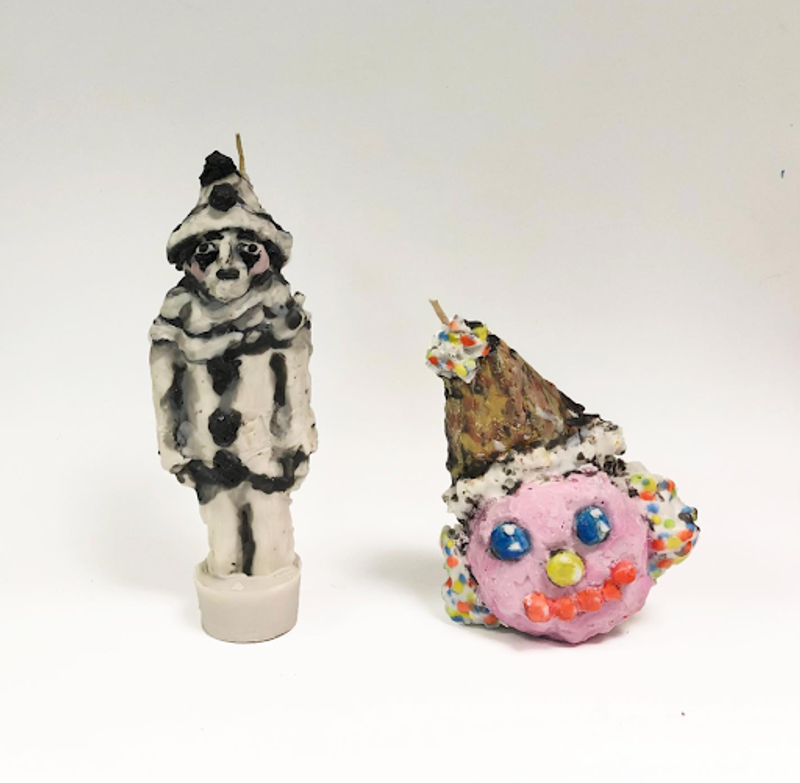
How did you get started? Did you have a wax mentor or a YouTube video you could pull up?
I didn’t really have any resources. I was doing clay sculpture, that was the last medium that I was using, and felt just like there was no response from people. I felt really stagnant. So I was either going to do candles, something that you could destroy through burning, or sculptural candy with marzipan. And I ended up eating all of my candy materials, so I went into wax. It was just a lot of trial and error because with what I’m doing it’s really hard to find a peer. It’s hard to get more educational resources because I don’t think there are a lot of people who are using [wax] in the same way.
So your life would look really different today if you didn’t have a sweet tooth?
Yeah.
Do you remember the first candle you made?
The first candles I made were made to be manifestation candles, so without any religion involved, more creating a very personal ceremony. I would think of what I wanted, which at that time was probably related to abundance or financial security, because I wasn’t having a lot of success with my previous art practice, and I would rub glitter on these candles that I made or put gold leaf on them. If it was for money, I would put dollar signs. That was the original intention. It was just a very personal ceremony between me and my hopes. I sort of outgrew that, but I feel like some of that still lives in the candles, which is that lighting them produces a ceremony and you can put whatever meaning you want into that.
Were you thinking about them as art pieces then or were they purely functional?
I was thinking of them as an interactive experience at the beginning— wishing on this thing and then I’m going to destroy it. And then it just grew from there.
How did that evolve into the wax sculptures you’re known for today?
[Laughs] I didn’t want to promise people magic candles. I mean, for me they’re magic, but I can’t promise that to anybody else. I think by giving somebody a candle of this weird thing that I come up with, or a portrait that they think is special, I’m leaving it open for them to create their own interaction.

Did you have a relationship with candles as ceremonial objects growing up?
In different degrees. Now I look back and I see that I did, but when I started making candles it didn’t occur to me. We would practice shabbat in our household. So holding the candle sticks and blessing them is a whole ceremonial practice we would have every weekend. And while it celebrates life, it’s also what we use to memorialize people, so there’s a yahrzeit candle. Looking back, our household always had candles and I guess they left more of an impact than I thought.
Also, in synagogue, they have these walls of names to commemorate the anniversaries, the yahrzeit of everybody. I was obsessed with this wall of lights. They were electrical lights that looked like candles and I would leave synagogue and just sit in the hallway and play with the lights, which one should not do. I was too young. I didn’t know better. It would be somebody’s anniversary of their death and I’d turn it off.
How old were you?
I mean, I probably learned better to stop doing that around nine, but in my infancy until then.
What’s the learning curve like for working with wax? Was it harder or easier than you expected?
It’s very different from what I expected. There’s a speed that you have to work with that’s different from using watercolors or oil paint. You have to be really fast and intentional because it will start to solidify on the paint brush. But I really think that with any skill it’s just about putting in the effort to learn the nature of the paint. You learn the times. I don’t use thermometers. At this point I just know how it feels in my hand. I’ll touch it and know there are 30 more seconds before it’s going to go rock hard on me.
How much time do you have before the wax solidifies?
It depends on what I’m doing. If I’m building it with my hands, I probably have like a minute of building time. And then when I get to the point where I’m painting the color, because I paint with wax, I probably have 10 seconds to apply that paint or the wax to the candle before it’s too hard to move.
It sounds like a lot of the thinking and creative decision making has to be done before you start.
Yeah, you need to know what you’re going to do. But I also think the art takes place in the accident, when it runs a little bit or if it blends. There are all these different tricks to it.
Like what?
If you want to turn it into this beautiful watercolor sort of translucent thing you do less pigment, more wax. You don’t press so hard on your paintbrush. It’s all stuff that I’ve learned through accidents. So even though I want to be super precise and planned out with what I’m doing, I try not to be too rigid about it because I learn every time. I mean I still learn because I’m still making mistakes.
Is the material pretty forgiving when it comes to mistakes?
To some degree, because that’s sort of my process of working. I’m constantly building and then I carve everything down. Then I’ll paint it. Then I’ll carve it down again. It’s not that easy to fix something, but you can go over it and you can chop it off.
Do your candles bear any resemblance to the sculptures that you were making previously with clay?
I think what I maintained from the sculptures is this sense of humor that I think is the throughline with most of my work. That was also in the animation I was doing. It’s filled with references to books and movies and whatever, but it’s with a side dish of sarcasm or it’s accompanied by a little bit of humor.
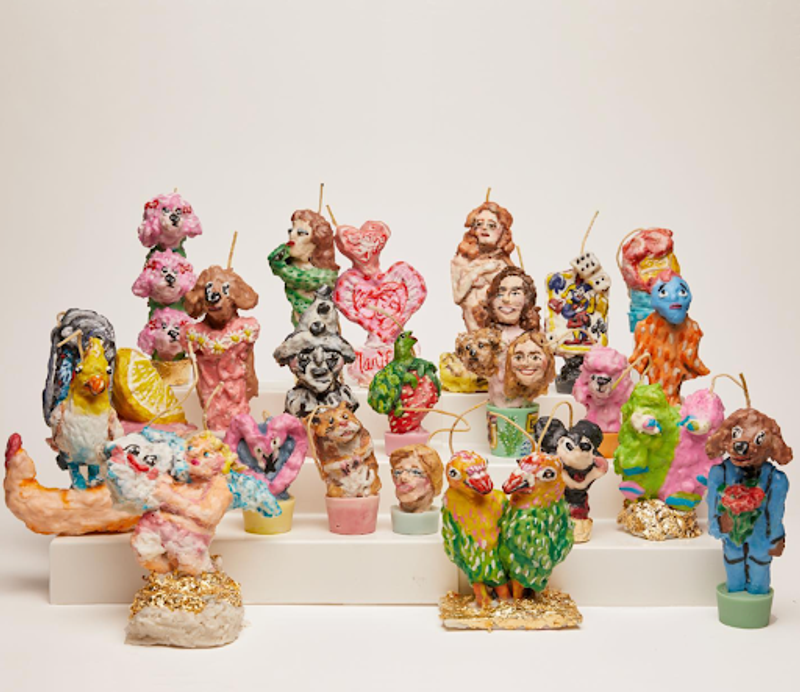
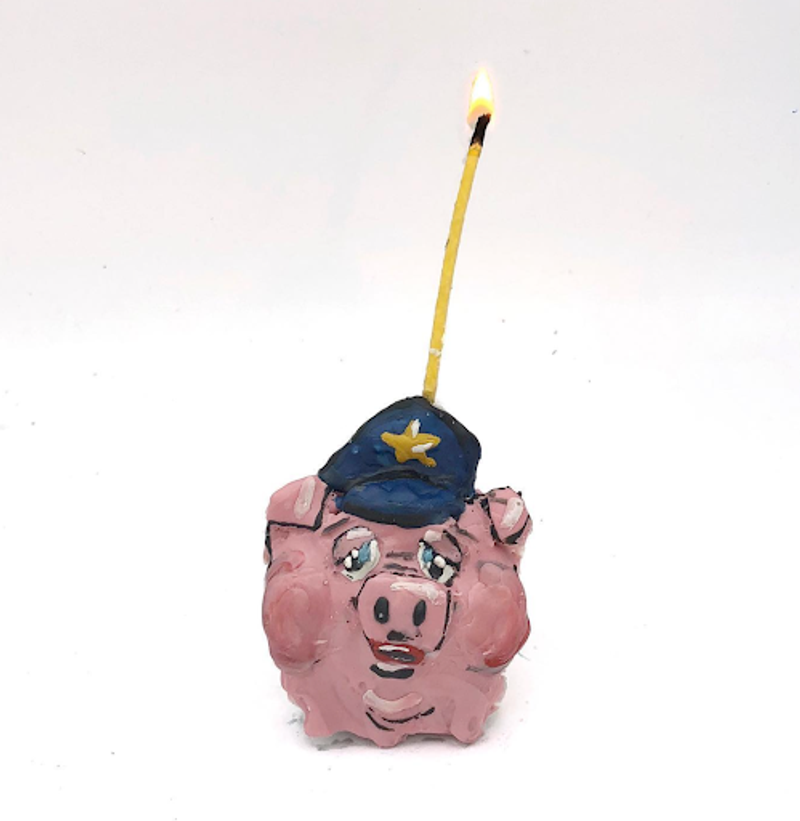
In looking through your work, many of the objects or people you choose to personify through wax exist in a very specific pocket of the cultural imagination. I’m thinking about the dancing baby from Ally Mcbeal or Clippy from Office Assistant or the vibrating bed from The Sims. How do you know when something qualifies as Janie Korn candle material?
I know it’s a Janie Korn candle if it’s something that is slightly grotesque, slightly funny, definitely nostalgic. And I’m not making it to mock whatever that object is or whoever that person is.
Irony feels beside the point?
I mean there’s humor, but I don’t want it to ever be ill intentioned. I think when you have this bit of nostalgia that’s isolated and considered an art object then we’re allowing ourselves to elevate it and really consider what that thing is or who that person is. I’m trying to think of an example…
Like the bowls of cigarettes at Mary-Kate Olsen’s wedding?
Yes. [laughs] Like those bowls of cigarettes, or like hentai Mrs. Potts. It’s something that could be a silly frivolous thing but by turning it into a candle that you could light—it could be on the Shabbat table or elevated into a ceremony— we’re re-contextualizing it. So it is this frivolous thing, but maybe it’s more culturally significant than we’re classifying it to ourselves.
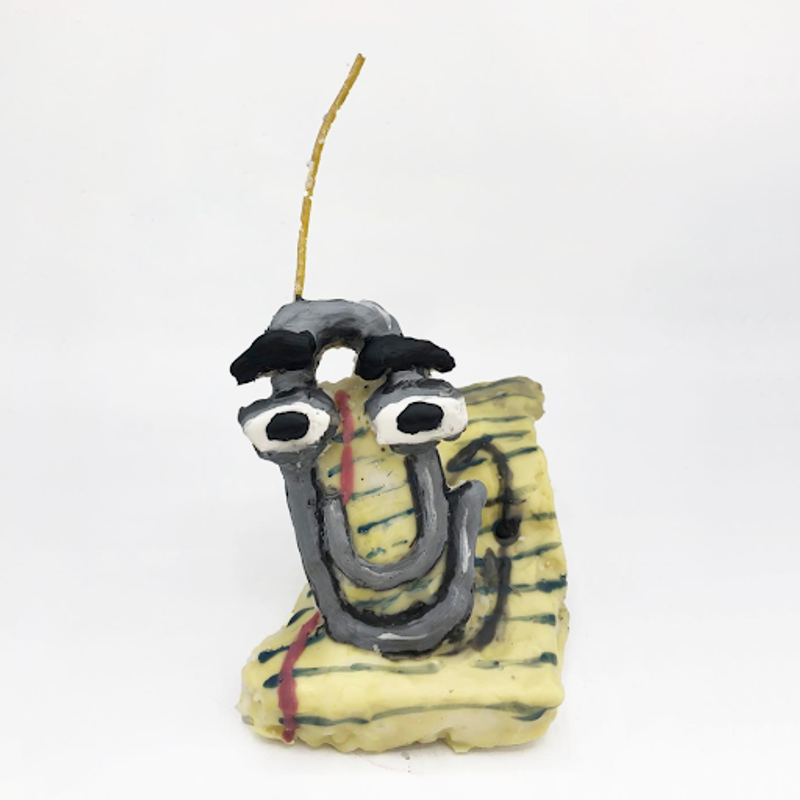
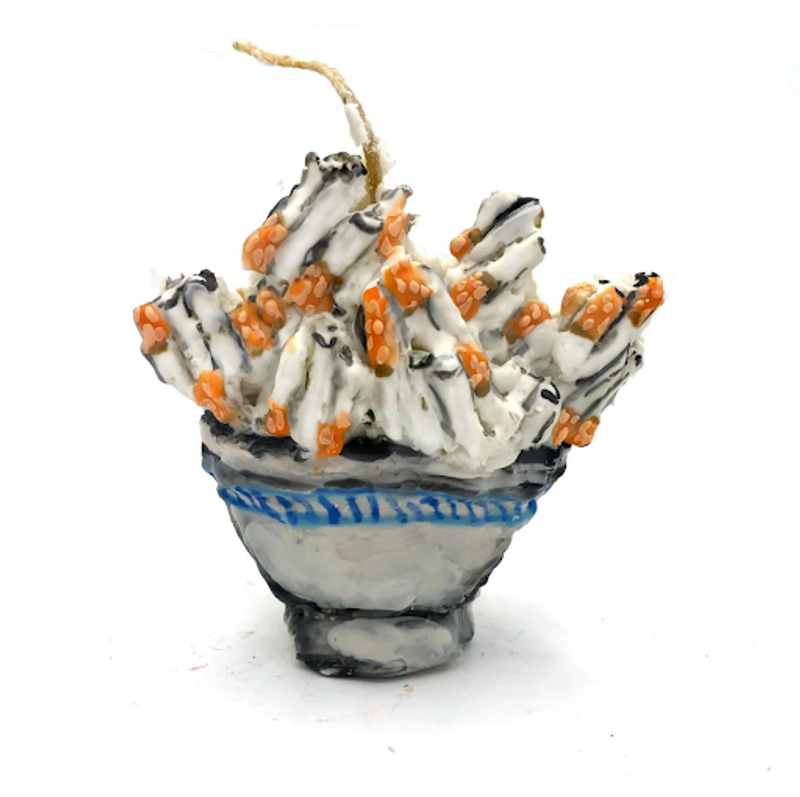
I’m glad you brought up the humor in your work, which translates to not only the objects you choose to depict but how you depict them, in these uncanny waxy forms. To what extent do you think about your work in relation to caricature, if at all?
That’s something that I think about a lot. I’m working on this bigger project right now that’s wonderful and kept me really busy but I think in the next couple months, when I get a break from it, something really important to me is considering how to grow and not making the body of work feel like it’s getting into the genre of caricature. I also do a lot of commission work, that’s the main source of my income, so I really would like to take a break somehow or find time to give my work more of an art treatment for myself.
Your work has been exhibited in a number of different art fairs and galleries. How do you think about that part of your practice in relation to all the commissions you do?
Whenever I’m feeling creatively blocked, which I think I’m sort of experiencing right now, I like to plan a show—the last one me and a perfumer put on together— or I will start to explore other mediums. So right now I’m taking a ceramics class. But I mean, I don’t know how one does it. I never want to turn down [commissions]. I’m a very “yes to everything” person.
Does that come from that feeling of “how long is this going to last?”
“How long is this going to last?” And also if this is supporting me, which is great, and I’m still doing what I love to do—at the end of the day, I’m making art, but it’s not my concept—how do I say no to that and sort of trust that more money will come when I do follow my creative instincts?
Do you think of yourself as a brand?
I think I probably started to think of myself as a brand two years ago, when things started picking up for me. And because I’m not doing as many commissions as I’m working on this big project I’ve only recently started to reconsider what that means. Of course I want to grow my business, but I don’t know if looking at myself like a brand is healthy for my identity.
Is it that there’s something at odds with that brand identity and the identity that you have as an artist?
Yeah. I think where I exist in the art world is like this weird limbo of art-object. It’s hard to grow creatively when you’re a brand.
How much does Instagram play into that? I’m thinking specifically about how it can function as both a self-imprisoning mechanism creatively but also, I’m assuming, how most people discover your work.
Instagram plays into it a lot. I think it’s a really big trap for me. Like only making work that performs well or also just feeling the sense of urgency to make anything, to perform for this audience that you feel like you have to keep constantly entertained and they have to like what you’re doing and when things don’t perform well, it’s not good for me. Right now I’m not really creating anything new and it breeds this sense of competition with other people, with your peers, and I hate that. I like to support the people I love and it’s just a nasty ecosystem because I find myself being so critical of myself and then so envious of other forms of success. But it’s also great that you meet people and whatever.
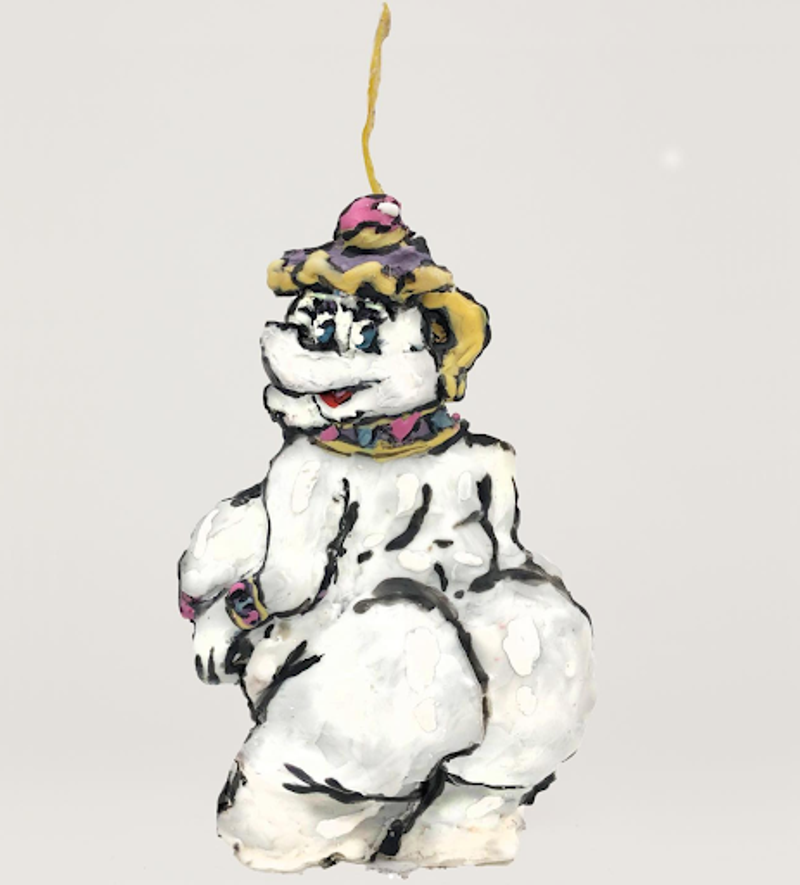
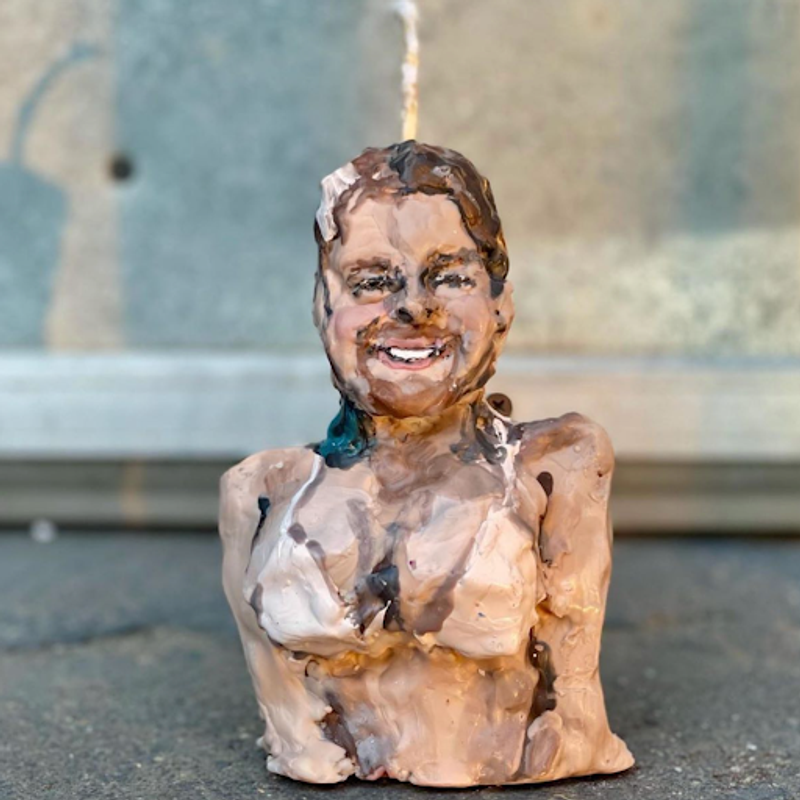
If someone at a party asks you what you do, what do you tell them?
Oh, it depends on who I am around. I say “visual artist” around some people and I’ll say “candle maker” around some people. I try to target it to who will make me feel less uncomfortable or who would understand it better.
So for moms is it “candle maker” and “visual artist” to other artists?
I think around fine artists, like a blue chip artist, I’m going to say “candle maker.” And then around my mom’s friends I’m going to say “visual artist.”
What does working from home look like for you?
My living room is converted into the studio, so I have two big bookshelves. I have my workbook. I have my boxes. I have a very big living room. It fits everything, thank god.
Do you boil wax in the living room too, or in the kitchen?
In the living room, on my desk. I have my double boiler and my pot and my melting station. So everything happens in the living room.
Wow.
It’s not a living room anymore. It’s a studio. I have had studios offsite before and I really like having my studio in my home because I can work at all hours. The only thing is the wax gets everywhere. So I have two sets of headphones. I’m talking to you on my business headphones, not my personal headphones. It gets everywhere. I sweep the floors probably three times a day. Eventually I’m going to go back to getting a regular studio, but it is nice to have everything at hand.
Is wax hard to clean?
I deep clean everything, but I try to keep it isolated to the living room. I sweep multiple times a day. I have laundry that I get laundered separately. It’s messy.
Does separating work from life ever feel like a struggle? Or does work feel like a natural extension of your life at this point?
Yeah, I work every single weekend. I work every day, but I don’t think that I even mind because of the pandemic. It’s like, what else am I going to do? So I like having it at hand. I just work all the time. Not in a bad way. I break it up by taking three walks a day and then when I’m not walking, I’m working. It sounds depressing. [laughs]
Are all your walks on the same route?
Yeah, I’ll pretty much only stay in the West Village and I won’t cross certain streets. I won’t cross busy intersections. So I’ll circle and circle until I’ve gotten my energy out. I feel like I treat myself like a dog. I get my morning walk, my afternoon walk, my evening walk. It works [laughs]. I haven’t gone fully unhinged yet. It keeps me scheduled. It’s my routine.
Physically, is there a limit to how much your body can work with a material like wax?
No, it’s more mental than physical, and that’s when I stop working each day, when I just can’t continue. I also start late sometimes, so if I’m reading in the morning maybe I’ll take a later walk and I’ll eat lunch and then start work at like noon and then I’ll work until 7:30 or 8:00 or 8:30 [at night].
Do you have any concerns about burn out?
Oh no yeah, I have burned out. I’m burnt out actually. [laughs] I’m existing. Yeah, I’m trying to break it up a little bit more. That’s why I signed up for a ceramics class.
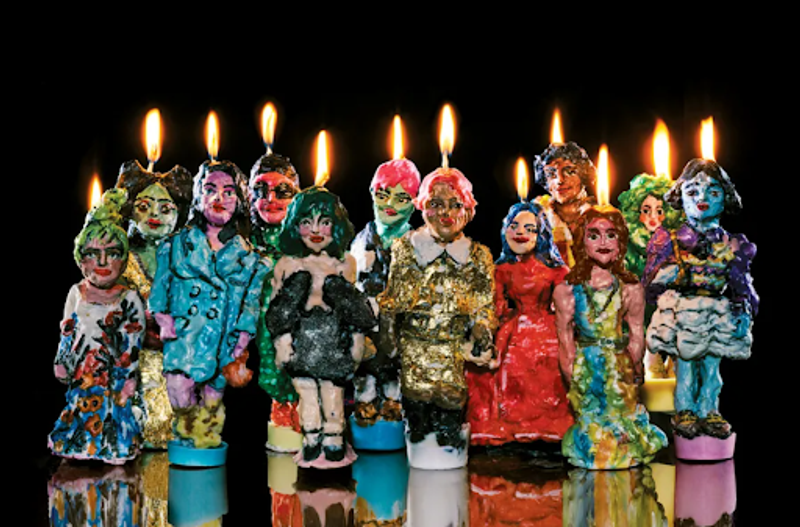
In thinking back to the ceremonial aspects of candles, how do you feel about people actually lighting your work?
I have changed my stance on it. I put so much time and love into the candle, and to me it is an art object, but when it leaves my house now I think it’s sort of badass for somebody to burn that, to destroy my work, to respectfully demolish it. I think that that’s sort of neat because they also know what went into it and they also know how much they paid for it. They know it’s something of value. I would hope that bearing all that in mind it’s a meaningful experience for them. So if they’re doing it with intention, I find it very thrilling. I would love, and this is just a matter of time and money, but I would love to set up a huge space and have a burn. I think that would be really cool.
What would that space look like?
Oh god, I guess it would have to be equipped with smoke detectors [laughs]. I just envision an intimate room filled with candles and I don’t know thematically what they would look like or if they were more abstract, but just filled with my work and then just burn it. Maybe somebody’s singing, I don’t know. I’d have to work with the symbolism or the meaning behind it. I mean, there’s something cool about burning all this time that you’ve spent building.
Janie Korn Recommends:
Goo Gone: It’s simply a modern marvel.
Ordering perfume samples online: I do it probably once a month, either from LuckyScent or from smaller perfumers, I feel like I’m buying an experience, so it is easier to justify than the other also frequent shopping I do.
The Chelsea Flea: this was my saving grace during early pandemic when Museums were closed. It’s open air, there are antiques, and clothes, and books, and a vendor that always offers me vodka from his thermos. I go for the inspiration mostly. I think it’s New York’s finest flea.
Audm: A good way to sneak in your longform reads. I listen while working, gravitating mostly to profiles, because it feels live elevated gossip.
Paul Klee: A few days ago I was looking for candlestick inspiration within The Met’s online catalog and stumbled upon a Paul Klee I had never seen before—”Small Portrait of a Girl in Yellow”—and it sparked a renewed interest in his work. It’s simultaneously playful and moody; I can’t get enough. Plus, I found out his fans call themselves “Klee-mates,” for which I am greatly tickled.
- Name
- Janie Korn
- Vocation
- wax sculptor
Some Things
Pagination



